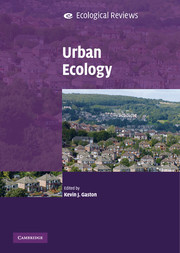Book contents
- Frontmatter
- Contents
- List of contributors
- Preface
- 1 Urban ecology
- 2 Urbanisation
- 3 Urban environments and ecosystem functions
- 4 Individual species and urbanisation
- 5 Species diversity and urbanisation: patterns, drivers and implications
- 6 Urbanisation and alien invasion
- 7 Interactions between people and nature in urban environments
- 8 Urban ecology and human social organisation
- 9 Urban ecology and human health and wellbeing
- 10 Bringing cities alive: the importance of urban green spaces for people and biodiversity
- 11 Integrating nature values in urban planning and design
- 12 Urban futures
- Index
- References
4 - Individual species and urbanisation
Published online by Cambridge University Press: 05 June 2012
- Frontmatter
- Contents
- List of contributors
- Preface
- 1 Urban ecology
- 2 Urbanisation
- 3 Urban environments and ecosystem functions
- 4 Individual species and urbanisation
- 5 Species diversity and urbanisation: patterns, drivers and implications
- 6 Urbanisation and alien invasion
- 7 Interactions between people and nature in urban environments
- 8 Urban ecology and human social organisation
- 9 Urban ecology and human health and wellbeing
- 10 Bringing cities alive: the importance of urban green spaces for people and biodiversity
- 11 Integrating nature values in urban planning and design
- 12 Urban futures
- Index
- References
Summary
Intraspecific variation in ecological and life history traits has interested ecologists since at least the nineteenth century (Bergmann 1847; Allen 1878; Gloger 1883; Jordan 1891). Such variation is still the focus of intensive research, but somewhat surprisingly the environmental factors driving large-scale patterns have rarely been firmly established and are intensely debated (Gaston et al. 2008). Turning to finer spatial scales, local variation in environmental conditions can promote marked trait divergence between adjacent populations. This raises important evolutionary questions regarding the role of phenotypic plasticity in generating such divergence, and the interactions between genetic adaptation and gene flow (Postma & van Noordwijk 2005; Senar et al. 2006; Ghalambor et al. 2007; McCormack & Smith 2008). The patterns and processes associated with trait divergence have, with the exception of a few classic studies concerning the effects of pollution, traditionally been assessed in relatively natural rural systems. Recently, however, there has been an explosion of research focusing on how the marked ecological differences between rural and urban areas influence the traits of conspecific populations. So far this work has largely emerged as a series of isolated case studies of trait differences, with the few attempts to synthesise the available information being confined to a subset of taxa or traits (Marzluff 2001; Bradley & Altizer 2007; Chamberlain et al. 2009). Assessments of intraspecific variation among rural and urban populations have also rarely been placed in the broader context of trait variation in more natural systems.
- Type
- Chapter
- Information
- Urban Ecology , pp. 53 - 87Publisher: Cambridge University PressPrint publication year: 2010
References
- 31
- Cited by

